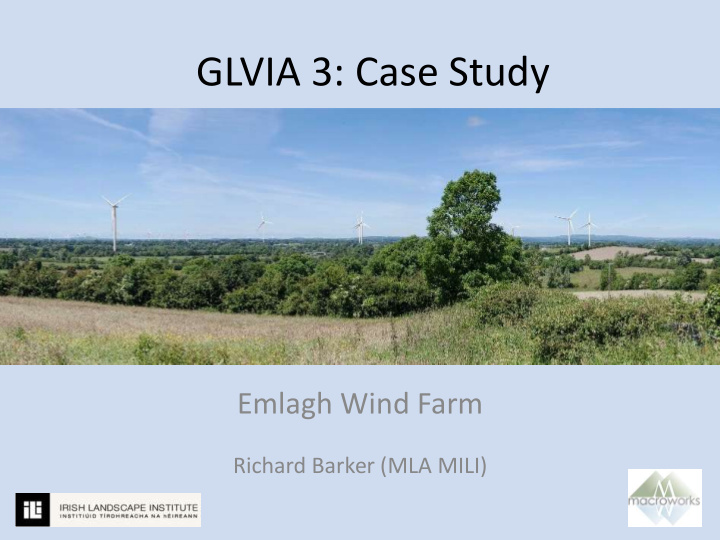



GLVIA 3: Case Study Emlagh Wind Farm Richard Barker (MLA MILI)
Introduction • Why choose Emlagh Wind Farm as a case study? • Presentation structure: – Principle of the project – Objectives – Approach – Early Stage GLVIA 3 considerations – Innovative techniques – Key Issues and Findings – GLVIA 3 critique
Principle of the project • Wind turbines coming down from the hills … an emerging trend • An SID project in-line with national renewables policy • Is this what the age of renewables will look like? • Another layer of a ‘palimpsest’ landscape? – much written over manuscript. • ‘Duration’ and ‘Reversibility’ of impacts • Experience with previous lowland wind farm projects … much higher degree of screening than people expect
Objectives • To target preconceptions and misconceptions in a balanced way … – “ This wind farm will be seen from all over Meath and surrounding counties” – “I’ll see 46 turbines out my back window! ” – “ This scheme will destroy the Heritage County” • To use empirical data wherever possible to support the appraisal • To produce a defendable, transparent and impartial appraisal
Approach • Stick like glue to GLVIA 3 • Where possible, use innovative / defendable techniques to establish and present the nature of turbine visibility • Simplify the presentation of the LVIA • Use visuals and graphics wherever possible to illustrate process and findings • Develop a clear crossover of responsibility with the project heritage specialists
Early stage GLVIA 3 considerations
Early stage GLVIA 3 considerations • Necessarily complex and iterative process • Turns the subjective ‘dark art’ of LVIA appraisal into a transparent sequence of objective, professional judgments • This is deliberately not prepared as a ‘how - to’ recipe book… • Use of professional judgment in decision making is a recurring theme • Scoping is a matter of professional judgment in consultation with the relevant Planning Authority • Appendix of ‘Best Practice’ assessment examples from GLVIA 2 removed • Prescriptive language seldom used… • “Could”.. “Should”.. “May” rather than “Shall”… “Will”… “Must” • Use of emerging technologies and alternative methods of presenting material is encouraged where it helps the understanding of the appraisal
What innovation? • Theoretical Visual Intensity (TVI) mapping • ‘ Streetview – like’ Route Screening Analysis (RSA) • Google Earth (KML) based viewpoint selection • Online 360 o photomontage viewer • ‘ Panopod ’ public consultation display modules
ZTV vs TVI mapping – Why?
How TVI mapping works
Standard ZTV map for Emlagh Wind Farm
TVI Map for Emlagh Wind Farm
Route Screening Analysis
Route Screening Analysis
Route Screening Analysis
Online 360 o Photomontage viewer
‘ Panopod ’ Photomontage Display Units
Key Issues and findings • Objector concerns related to local receptors and heritage receptors – highlighted distinctly different viewing contexts • Broad distant views of scheme vs close partial views of a few turbines • Landscape values • A supplementary layer of productivity within a working rural landscape or industrialisation and redefining of a pastoral setting • Application of the DoEHLG Wind Energy Guidelines (2006) • Still fit for purpose? • Applicable landscape type? • Determining responsibilities and interaction between project LVIA specialists and project Heritage Specialists • Relevant receptors – public vs private • Change to landscape / visual context vs change to setting of a heritage feature
Variation in visual context
Variation in visual context
Rural landscape with wind turbines or a ‘Wind Energy’ landscape?
GLVIA 3 critique • Complexity of appraisal process largely lost on public • Suggestions of deliberate bafflement • Perceived manipulation of ‘sensitivity’ vs ‘magnitude’ approach • However - allowed for defendable process • The use of new forms of visibility analysis not challenged in relation to GLVIA or ‘best practice’ • Either overly complex or deliberately ignored? • Public vs private viewpoint selection – some ambiguity • Stately homes (periodically open to the public) • Provision for private viewpoints, but only in the context of a separate ‘Residential Amenity Study’ (GLVIA Section 6.15) • LVIA / Heritage crossover could be more explicit • “…danger of both double handling and inappropriate judgments by non -experts. It is particularly important that responsibilities are clear in considering any effects on the settings and views for historic buildings, Conservation Areas and other heritage assets” – GLVIA Section 5.11
So what happened? • ABP inspector generally agreed with LVIA findings and recommended approval of the project • After approximately 6 months of deliberating The Board narrowly opted to refuse planning permission substantially on grounds of landscape and visual impacts (scale, extent and height of the scheme…amenities of property in the area….character of the landscape) • A substantially refined and consolidated version of the original Emlagh development (Castletownmoor) applied for in June 2016. Still in the SID planning process
Recommend
More recommend